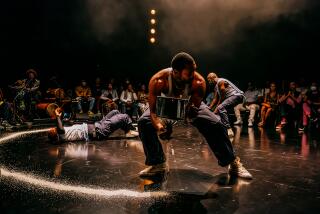Review: ‘Watershed’ misses its moment to commemorate civil rights

Sometimes talent isn’t enough — if it isn’t the right kind of talent.
Choreographer Kyle Abraham has won “Bessie” and Jacob’s Pillow awards, a MacArthur grant and commissions galore. But in attempting to evoke or commemorate the struggle for civil rights both here and in South Africa, his two-part epic “The Watershed” becomes, at best, a declaration of sensitivity, at worst a numbing theatrical experience.
At UCLA’s Royce Hall on Thursday, his multiracial 10-member company, Abraham.In.Motion, faultlessly executed his style of postmodern abstraction — a style as comfortable with modern dance vocabularies as movement born on the street. And the solos at the beginning of each half of the 90-minute performance provided a sampling of Abraham at his most seductive.
As if propelled by an uncontrollably restless spirit, Catherine Ellis Kirk swirled into passages of liquid energy, then subsided into moments of rapt stillness before sudden torso accents drove her back into the surge. Just after intermission, Abraham himself continually used torso moves to throw himself off center — out of balance — only to effortlessly remain perfectly upright, his inner gyroscope clearly state of the art.
Unfortunately, such showpieces didn’t support the evening’s ambitious premise. Artist Glenn Ligon designed a stark lynching tree for Abraham, and before the performance began projections on the backdrop documented the deaths of black people from the end of the 19th century to the killings of Michael Brown, Tamir Rice and others recently in the news.
But “The Watershed” never matched the gravitas of these graphic statements with dramatic power. Indeed, its sole expressive ploy was juxtaposition: abstract dance juxtaposed to projected quotes (some of them exposing racism, others merely informative); or film clips (everything from Shirley Temple with Bill Robinson to news footage of police dogs, fire hoses and other brutal methods of crowd control ); or intense music and sound effects (12 credited composers).
It wasn’t enough. The choreography rarely absorbed emotional power from its visual or sonic accompaniments, and what you felt about “The Watershed” ultimately depended on what you brought to it.
In Act 1, Karen Young’s costumes suggested the American past, and the dancers performed brief character vignettes that never linked up, though they provided opportunities for exemplary soloists such as William Briscoe, Connie Shiau and Jordan Morley. Same-sex duets and a drag impersonation by Abraham introduced the theme of homosexuality inside and outside the black community — worth exploring but not as a sideshow to a piece supposedly grounded in the aftermath of the Emancipation Proclamation and apartheid. Indeed, too many episodes proved thematically irrelevant or diversionary — almost like an assignment from Dance 101: Play a record and move to it.
In Act 2, everyone wore black or gray, and here Abraham largely obliterated individual excellence with nonstop unisons, sometimes splintered by dancers who periodically collapsed and eventually rejoined the group. Once again he varied the pattern with drag flamboyance (Briscoe this time), but the ploy went nowhere. Had the ensemble choreography been more forceful, you might have taken the result as a metaphor for ongoing struggle. But even then, what to make of the final musical juxtaposition: the candied exoticism of the temple scene from Verdi’s “Aida”? Was Abraham being ironic about his own insufficiency?
Choreographers with far fewer moves in their arsenal have come closer to making us feel the pain and consequences of oppression. But Abraham just hasn’t the right tools or training for movement theater. We can hope that the failure of “The Watershed” will either send him off to gain what he lacks or encourage him to stay in his comfort zone.
Either way, his audience will be the winner.
More to Read
The biggest entertainment stories
Get our big stories about Hollywood, film, television, music, arts, culture and more right in your inbox as soon as they publish.
You may occasionally receive promotional content from the Los Angeles Times.










